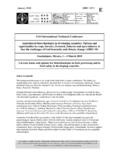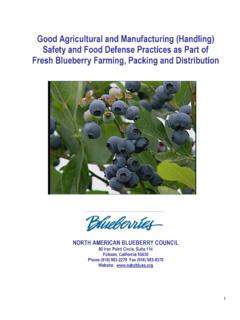Transcription of THE BASIC PRINCIPLES OF HACCP - Egyptian Food …
1 The BASIC PRINCIPLES of HACCP . THE BASIC PRINCIPLES OF HACCP . The Meaning of HACCP . History of the HACCP System Traditional Inspection HACCP System The Seven PRINCIPLES of HACCP .. The BASIC PRINCIPLES of HACCP . Meaning of HACCP : Hazard Analysis and Critical Control Points Why HACCP ? HA = Hazard Analysis +. CCP = Critical Control Points . The BASIC PRINCIPLES of HACCP . HACCP Application BASIC Agriculture food Processing Distribution and Marketing Catering Services Street Foods Use by consumers HACCP Objectives : Eliminate or significantly reduce hazards Prevent or minimize microbial growth and toxin production.
2 Control contamination.. The BASIC PRINCIPLES of HACCP . HACCP : emphasizes process control focus control on critical points related to food safety values communication between food producer and inspection HACCP . Preventive and not reactive (traditional inspection). Tool used to protect food from biological, chemical and physical hazards . The BASIC PRINCIPLES of HACCP . HISTORY OF. HACCP . In the 1960s the Pillsbury Company developed a program for the production of safe foods for NASA space program In 1971, Pillsbury presented HACCP system to the public for the first time In 1973, it was applied to low- low-acid canned foods.
3 The BASIC PRINCIPLES of HACCP . Recommendation of the National Academy of Science In 1985, NAS recommended that food sanitary agencies, as well as food industry in the US, should apply HACCP . In 1993 Directive CEE relative to the hygiene of foods. Why HACCP ? The Codex Alimentarius Commission decided to adopt the acronym HACCP , regardless the translation of Hazard Analysis and Critical Control Points in any of the official languages of the United Nations . Uniform understanding . The BASIC PRINCIPLES of HACCP . The Codex Alimentarius Commission, in its twentieth session, held in Geneva, Switzerland June 23 - 28,1997, adopted the revised Recommended International Code of Practice General PRINCIPLES of food Hygiene PREREQUISITES FOR.
4 HACCP IMPLEMENTATION.. The BASIC PRINCIPLES of HACCP . Prerequisite programs to implement HACCP : - Good Manufacturing Practices (GMP). - Sanitation Standard Operating Procedures (SSOP). Preliminary steps need to be accomplished before applying HACCP . Prerequisite programs Preliminary steps needed to control conditions related to safe food production Examples: Hygiene and sanitation of equipment Training of employees Preventive maintenance Product identification . The BASIC PRINCIPLES of HACCP . Good Manufacturing Practices - GMP. Prerequisite to implement HACCP . Some aspects involved: hygiene and personal health issues design and maintenance of buildings and equipment calibration of equipment use of ingredients cleaning and sanitation THE SEVEN.
5 PRINCIPLES OF. HACCP .. The BASIC PRINCIPLES of HACCP . THE SEVEN PRINCIPLES OF HACCP . 1. Perform a Hazard Analysis (HA) and establish the corresponding preventative measures 2. Determine the Critical Control Points Points (CCP). 3. Establish critical limits limits for each CCP. 4. Establish a system to monitor control of the CCP. 5. Establish the corrective action to be taken when monitoring indicates that a particular CCP is not under control. 6. Establish procedures for verification to confirm that the HACCP system is working effectively. 7. Establish documentation concerning all procedures and records appropriate to these PRINCIPLES and their application.
6 PRINCIPLE 1: HAZARD ANALYSIS. Conduct a hazard analysis and identify the preventive measures . The BASIC PRINCIPLES of HACCP . PRINCIPLE 1. APPLICATION : 1. Assemble HACCP team: Accomplished by assembling a multidisciplinary team. 2. Describe product : Including information of composition, physical/chemical structure ( Aw, ), microbial compositon, packaging, durability and storage conditions and delivery method. PRINCIPLE 1. 3 Construct flow diagram : The flow diagram should cover all steps in the operation. 4. List all potential hazards associated with each step, conduct a hazard analysis, and consider any preventive measures to minimize the identified hazards.
7 The BASIC PRINCIPLES of HACCP . Example of a Flow Diagram Receiving Cooking Freezing Boxing Distributing PRINCIPLE 1. Hazards can be: Biological Chemical Physical . The BASIC PRINCIPLES of HACCP . PRINCIPLE 1. Biological hazard: bacteria, viruses and parasites, natural toxins, microbial toxins, metabolic toxins resulting from a bacterial source. PRINCIPLE 1. Chemical hazard: pesticides, herbicides, inorganic contaminants, antibiotics, growth promoters, food additives, lubricants, paints, disinfectants.. The BASIC PRINCIPLES of HACCP . PRINCIPLE 1. Physical hazard: glass, metal and wood fragments or other objects that may cause physical damage to the consumer PRINCIPLE 2: CRITICAL CONTROL POINTS.
8 Identify the Critical Control Points (CCP) in the process.. The BASIC PRINCIPLES of HACCP . PRINCIPLE 2. Critical Control Point (CCP). "a step at which control can be applied and where it is essential to prevent or eliminate a food safety hazard or to reduce it to an acceptable level.. PRINCIPLE 2. Points identified as CCP when hazards can be avoided: Introduction of pathogenic microorganisms or drug residues can be avoided during the reception of raw material Chemical hazards can be avoided by controlling formulation steps and addition of ingredients . The BASIC PRINCIPLES of HACCP .
9 PRINCIPLE 2. CCP When hazards can be avoided Contamination of final product by pathogenic microorganisms can be avoided by addition of preservatives and/or pH adjustment. Growth of pathogenic microorganisms can be avoided by refrigeration. refrigeration. PRINCIPLE 2. Points identified as CCP when hazards can be eliminated: Thermal processing for adequate time/temperature time/temperature can eliminate pathogenic microorganisms or reduce them to acceptable levels . The BASIC PRINCIPLES of HACCP . PRINCIPLE 2. CCP When hazards can be eliminated Metal pieces can be detected or removed using metal detectors, sifter screens, screens, de- de- stoners, stoners, clarifiers, clarifiers, air tumblers Freezing processes can kill parasites (Trichinella spiralis, spiralis, Cysticercus celullosae, celullosae, Anisakis spp.)
10 Spp.). PRINCIPLE 2. Points identified as CCP when hazard can be reduced to acceptable levels: The presence of foreign matter can be minimized by manual and/or automatic collector Some biological or chemical hazard can be minimized by proper selection of suppliers of raw material . The BASIC PRINCIPLES of HACCP . PRINCIPLE 2. CCP are specific to a product and process Many factors affect a CCP: - Replacement of equipment equipment - Changes in product formulation - Changes in operational flow - Size of packaging - Changes in GMP and SSOP. PRINCIPLE 2. Decision Tree to identify CCP.





